mytest
eBooks, Books, and more from ARUDOU Debito (click on icon):


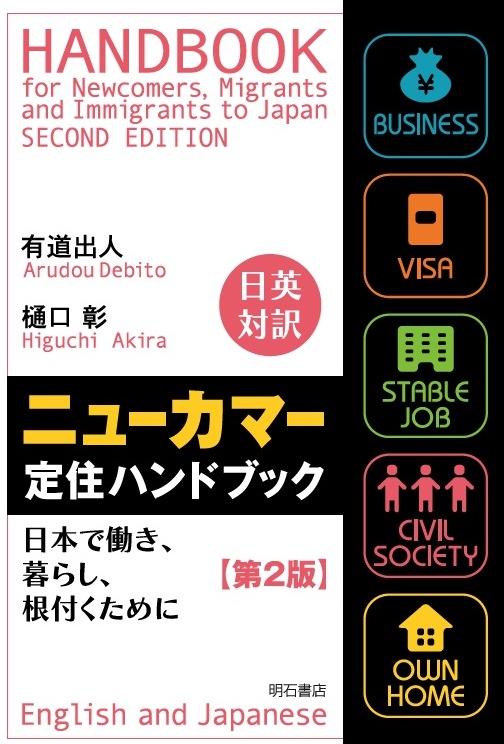


![]()


UPDATES ON TWITTER: arudoudebito
DEBITO.ORG PODCASTS on iTunes, subscribe free
“LIKE” US on Facebook at http://www.facebook.com/debitoorg
http://www.facebook.com/handbookimmigrants
https://www.facebook.com/JapaneseOnlyTheBook
https://www.facebook.com/BookInAppropriate
Hi Blog. It’s as predicted (if not encouraged) by Japan’s media: The rightist Liberal Democratic Party (LDP), along with its coalition partner “Buddhist Party” Kōmeitō (KMT), won an outright majority in Japan’s Upper House.
BACKGROUND
Background for those who need it: Japan’s Diet (Parliament) is a bicameral legislature, with a more-powerful Lower House (House of Representatiaves) and a more rubber-stamping Upper House (House of Councillors) that can block Lower House legislation. The Upper House holds elections every three years (Councillors have 6-year terms, and half the Upper House — 121 seats — goes up for election at a time), and yesterday was the Upper House’s most recent election.
The timing of this election was important to Japan’s accelerating swing to the Right. As Debito.org noted after last December’s Lower House Election, Japan’s rightwing parties — the LDP, KMT, and even a lunatic-Rightist fringe called the Japan Restoration Party (JRP, headed by the likes of xenophobic bigot Ishihara Shintaro and demagogic Hashimoto Tōru) — won an enormous victory over the ruling leftwing parties (particularly the Democratic Party of Japan, or DPJ, who had finally wrested power from the LDP, a party that had become very corrupt and inbred after governing Japan for most of its Postwar Era, in 2009).
How enormous a victory was last December’s Lower-House election for Japan’s Right? It put 3/4 of all Lower House seats in the hands of ultraconservative parties — ones who were openly stating they favored the reinstatement of a Japanese military (not just the “Self Defense Forces”), a revision of Japan’s Constitution to remove Postwar sensibilities regarding individual rights, and a very ahistorical accounting for Japan’s Wartime responsibilities; they were also quite nakedly playing up external threats to sovereignty by niggling over disputed ocean specks with China and South Korea (see here and here). These trends were enough to cause alarm in even dispassionate scholars of Japan, but no matter — the DPJ was voted out.
Thus yesterday’s election was to be a referendum on the past six months of Prime Minister Abe, who was previously PM last decade in a spectacularly inept LDP administration that went down in flames in less than a year. Although political Pollyannas said Abe would be restrained between January and July due to this election (indeed, he vacillated somewhat on his stance towards historical revisionism, such as Japan being involved in wars of aggression and wartime sexual slavery), Abe still made the election more about temporary economic upturns with a hint of constitutional reform — asking for a mandate to resolve the gridlocked Diet (gridlock he had caused, it should have been noted), while occasionally raising alarmist fears about outsiders and Japan’s sovereignty. Meanwhile, the DPJ could not make the main issue of the election how the LDP’s proposed constitutional reforms would abrogate everyone’s constitutional rights. The LDP’s campaign slogan was in fact “Take back and return Japan” (Nihon o tori modosu); readings by scholars noted that this meant taking Japan back not from the DPJ, but from a Postwar constitution back to something Prewar. So much for restraint.
So SITYS. Debito.org has long called for Japan’s rightists to bring it on and show their true colors — so that Japan’s voters could decide whether they really wanted reactionary arch-conservatives to tinker with their civil and political rights. It looks like they have. Debito.org has also warned what would happen if Japan’s Right got what it wanted. Turns out voters didn’t seem to care, for now with this resounding Upper House victory, they have given Abe the mandate to do so. Let’s crunch some election results and then offer some conclusions:
ELECTION RESULTS
These results are from Japan’s mainstream media, so there is nothing particularly specialist in these analyses. I will take screen captures from the Asahi Shinbun’s website at Asahi.com, dated Monday July 22, 2013, 2:15 AM JST, with all seats reporting in:
Here’s the makeup of how the seats went by prefectural electoral district:
EXPLANATION: Each box is a prefecture. Inside each box is a colored kanji representing one seat and, depending on the color, to which party it went. The navy blue ones are the LDP, the sky blue ones the coalition KMT. Red is the center-left DPJ, and within the fringe parties of note, the light green is the ultrarightist JRP and the orange is all-over-the-map-politically Your Party (Minna no Tō).
COMMENT: As you can see, almost every prefecture went LDP. Japan’s rightward shift is especially clear when you compare it to the distribution in the 2010 Upper House election:
and the 2007 Upper House election, which was quite decisively DPJ:
Now let’s look at how the Upper House looks in terms of seat distribution and assembly majority.
EXPLANATION: The uppermost grouping is the LDP/KMT coalition, denoting a total of 135 seats in the 242-seat Upper House. That gives them an absolute majority, as half the seats (visible in the horizontal bar chart) is 121. The 10 are unaffiliated and fringe parties, the 11 are the Japan Communist Party, and at 59 is the DPJ.
In the smaller greyer horizontal bar chart below the larger one, you can see the distribution of assembly seats before the election. Below that is a chart showing the seats distribution with this election (e.g., 65 for the LDP), plus the seats that were not up for election this time (e.g., 50 for the LDP), totaling the political power of 115 seats below that.
COMMENT: As denoted in the larger horizontal bar chart above, a 2/3 majority has been reached in the Upper House if one coalitions the JRP (at 9) and the Minna no Tō (at 18). This means a reform of Japan’s Constitution is now very possible if not probable.
Next, to see how much of a rout this election was for the DPJ, consider this bar chart for this election alone, not including seats that were not up for election this time:
EXPLANATION: The biggest seat getters were the LDP/KMT coalition at 76. They had 44 before this election. The other fringe parties, Minna no Tō (politically wild-card) went from 3 to 8, JRP (ultra rightist) went from 2 to 8, and JCP (leftist communist) went from 3 to 8. Clearly the biggest loser was the DPJ, which dropped from 44 to 17.
COMMENT: The Right is now clearly in control of the Upper House.
Next, Japan has a funny election system seen in other parliamentary democracies where the electorate votes for an individual candidate in a prefectural seat (senkyo-ku), and then votes for a second time for a political party (called hirei-ku, or Proportional Representation). So of the 121 seats up for grabs this time, 73 are for prefectural seats largely apportioned by local population numbers (i.e., larger population = more seats), while 48 are reserved for people who get votes on behalf of their party. So if people preferred an individual candidate but didn’t like their party, they could vote for the person and then a second time for a different political party. Here’s how those turned out:
At the top is the LDP again, which got 47 seats in electoral districts, and 18 seats from PR votes, total 65 seats of the 121 up for grabs, increasing their total seats in the Upper House from 84 to 115. You can do the same math for the other parties, which are, respectively, LDP coalition party KMT (sky blue, center-rightist), DPJ (red, center-leftist), Minna no Tō (orange, wild card), JRP (green, ultra-rightist), JCP (purple, leftist-communist), and other fringe parties in grey Seikatsu no Tō (political despoiler Ozawa Ichiro’s latest incarnation), Shamintō (leftist), Midori no Kaze (green leftist), Kaikaku (unknown leanings; did not field a candidate), Taichi (Suzuki Muneo’s demagogic party), the rest of the fringes, and the unaffiliateds.
COMMENT: Once again, the biggest winners were the LDP, the biggest losers the DPJ (which got as many as KMT and just one more than the ultrarightist JRP!)
TWO ELECTIONS OF NOTE TO DEBITO.ORG:
As talked about in previous blog entries, two candidates were notable a) for their underwhelmingness (Japan’s first European-born MP Tsurunen Marutei) and b) for their rabid xenophobia (the anti-Korean candidate Suzuki Nobuyuki). Suzuki first:
1) XENOPHOBE SUZUKI NOBUYUKI GETS MORE THAN 1% OF TOKYO ELECTORATE
In the end, Suzuki came in tenth (out of twenty candidates), which is not too shabby considering how extremely nasty he is. As of this writing, 74,083 people in Tokyo voted for him. I find that decidedly scary.
2) TSURUNEN LOSES HIS SEAT. NOT EVEN CLOSE
Finland-born Tsurunen Marutei, the human chameleon who got his Diet seat for two terms, did little of import with it, and then promised to change even the color of his eyes, decisively lost in the PR vote.
For the DPJ, he came in thirteenth, gaining only 81,856 votes (not all that many more than Suzuki, and this is a nationwide vote!). This is below the threshold allowed for the total votes cast for the DPJ, which gave only seven candidates (those denoted by red roses) a seat.
COMMENT: What an ignominious end to what could have been a noteworthy career. And if you think I’m exaggerating Tsurunen’s underwhelmingness, even the Asahi didn’t see Tsurunen’s loss (as Japan’s first Visible Minority elected to the Diet) as significant enough to include in the 63 “noteworthy races” (chūmoku no tōraku) they gave special coverage to.
CONCLUSION: I think Abe will now see this as vindication of his mandate, and we’ll see even more pushing of his rightest agenda to undo as many Postwar reforms as possible. Those will become very visible in the coming weeks. Vigilance.
Alright, that’s the bare bones of this election. Let’s open this up to Comments. Thanks for reading. Arudou Debito
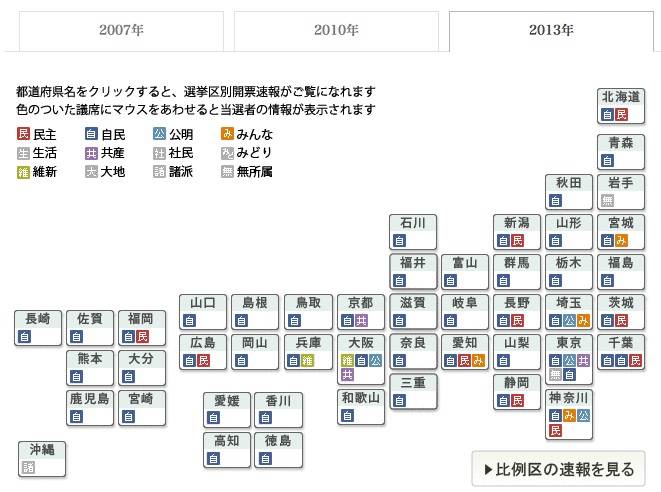
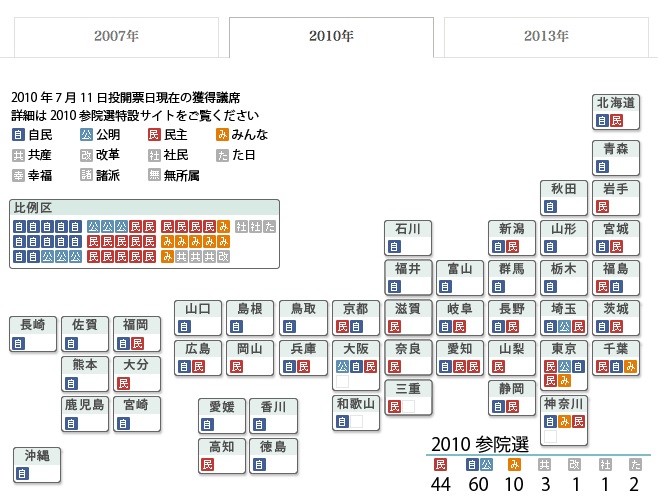

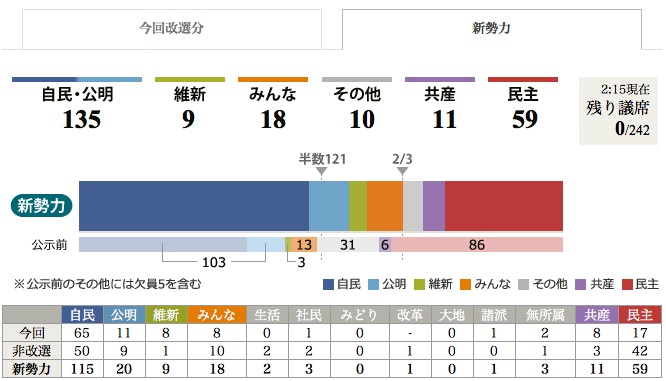
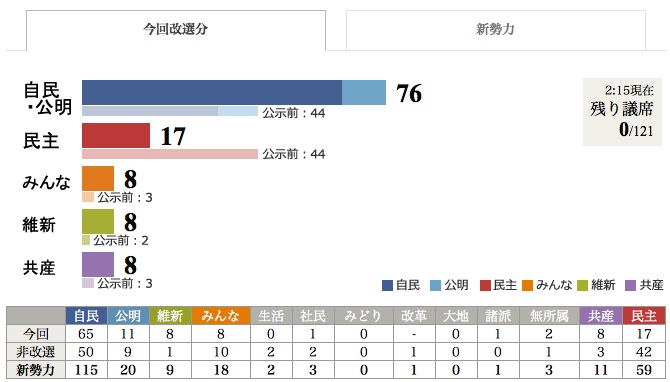
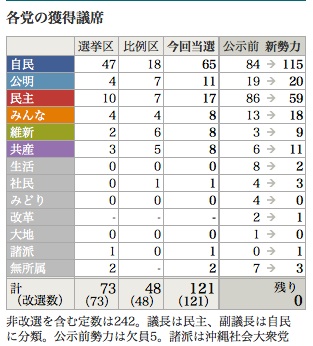
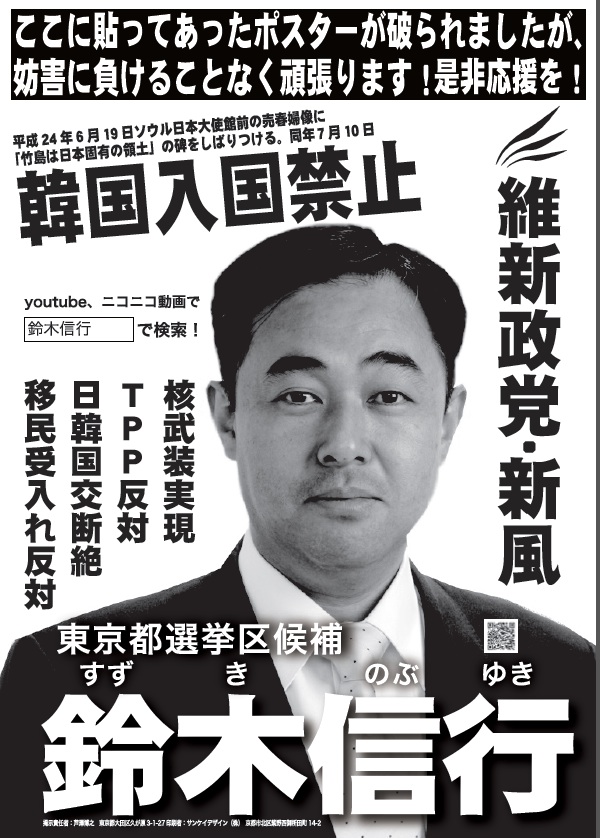
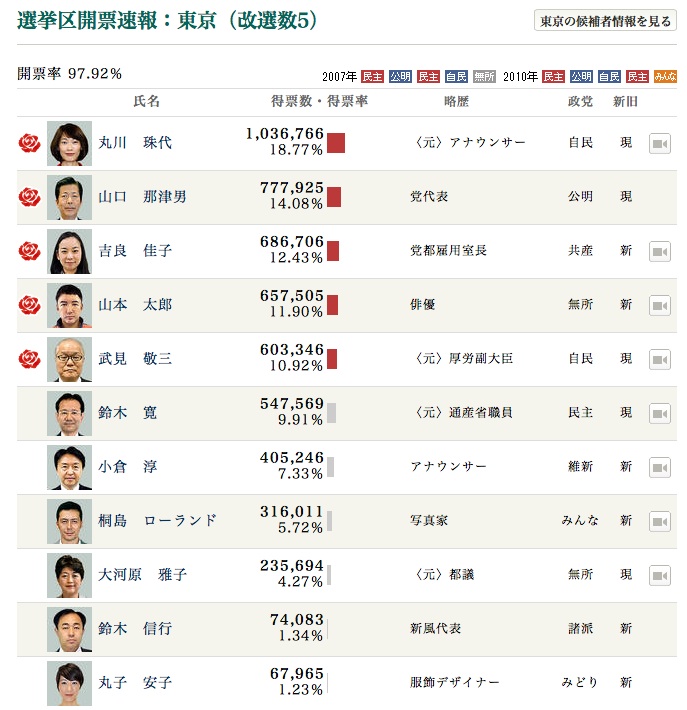


53 comments on “2013 Election Special: The rout of Japan’s Left is complete with a crushing LDP Upper House Victory”
Comment navigation
Sorry to chime in too this late, but isn’t it time to admit that this movie, as most of his other movies, aren’t actually art, but rather quite trivial, adolescent fare? Sorry if this offends the animation fans here, but as with Haruki Murakami, the reputation as an artist is underserved in this case.
@Markus, #51
I don’t know. Most of his works can be considered as animation, but ‘Kaze Tachinu’ differs from other famous work that drives views to the fantasy, such as “Spirited Away” or “Totarino Totoro.” How to classify the difference between the two based on specific definitions is way more challenging than critiquing LDP’s attempt to manipulate constitutional language, I think.
When I was living in Japan, i always enjoyed reading your column in the Japan Times, now I can only do it from time to time; this analysis of the election seems quite clear and the power of Abe is now very strongly established. How far will he go? How fast? How long?
One thing amazed me that you did not comment.
This election was one of the worst ones since the end of WWII: only 52,69% of the Japanese who could have casted their vote did it. Thus the power was given to the right by around 1/3 of the Japanese potential voters.
Even within the winners, a significant proportion about nuclear arms, nuclear energy policy, about constitution change, TPP, have been elected showing an opinion different from what is supposed to be the Abe’s intent (see Mainichi poll).
Thus, could it be possible that the Japan people, the Japan civil society be very different from the official position of the Governement of Japan, supported by democratic elections ( even with a “special” system as you explain it).
Could we think that this is the result of the undercommitment of the Japanese citizens in the political life and of a lack of involvement of almost political parties along clear option (eg social democracy, socialism etc.)?
Would it change, with more individual commitment or collective involvements (Green party so many years after all advanced countries in Europe..)?
Comment navigation